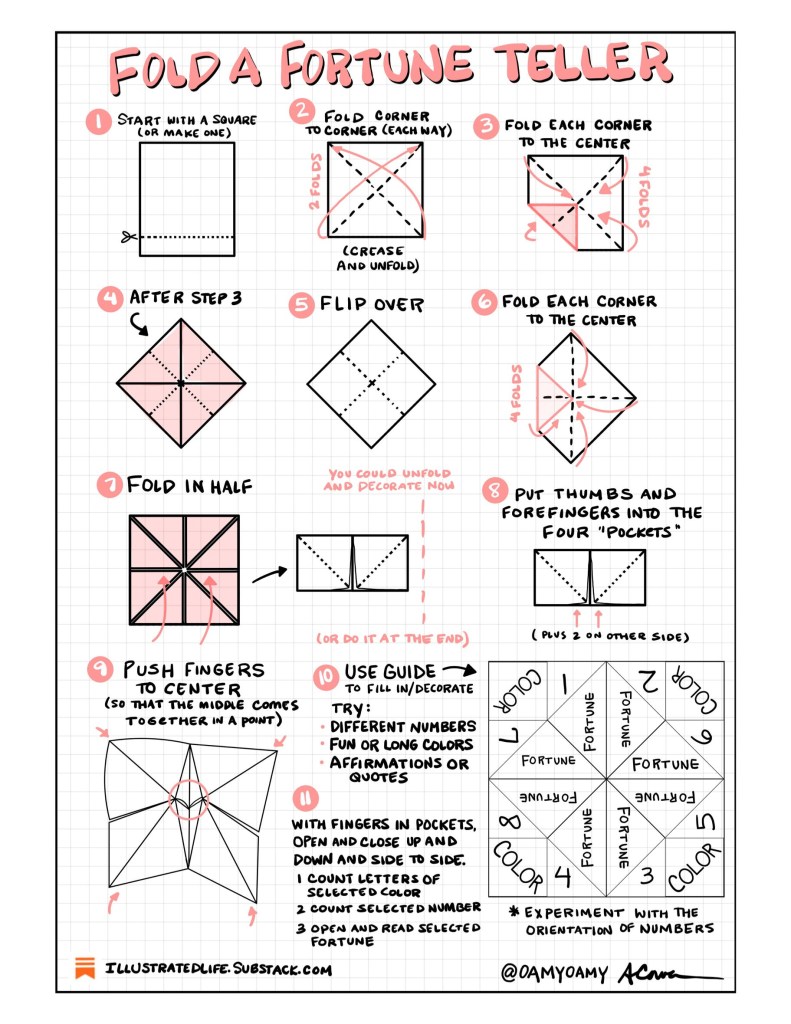Connecting Dots is a monthly column by writer Amy Cowen, inspired by her popular Substack, Illustrated Life. Each month, she’ll introduce a new creative postcard prompt. So grab your supplies and update your mailing list! Play along and tag @print_mag and #postcardprompts on Instagram.
Nothing is set in stone. A bird can be refolded into a boat, a fish, a kimono, or any other extravagant vision. At other times it aches to return to its original folds. The paper begins to fray. It tires, rebels.
Tor Udall, A Thousand Paper Birds
Send the Quiet of Folding — Postcard No. 11
With only two postcards left in this series, we could go in many directions to give voice to our desire to reach across miles, to connect, to share, to bolster, and to rekindle.
A postcard shook free from a pile of old papers this week, something I picked up years ago at the annual (now defunct) Roadworks Steamroller Printing Festival held by The San Francisco Center for the Book. (They literally drove a steamroller over paper in the road to make prints.)
The postcard wasn’t carved, but the context of that day, of the weight of the pressing, comes back to me when I see this card. It is oversized and features a tumble of paper origami cranes that are transforming to real cranes as they fly off the edge. I have a soft spot for paper cranes anyway, but seeing this postcard quietly and unexpectedly drift into view seemed fitting.
There is metaphor and mystery and mindfulness in the folding of paper, the rendering of form from a flat page.
This month, translate the spirit of origami into a postcard. Postcards need to be flat to make it through the mail, so the goal isn’t to fold and send origami. Instead, capture the spirit of folding and send that through the mail.
There are several ways to think about this:
Fold something and then draw or paint it on a card. Don’t limit yourself to a crane. There are countless folds you might try. Consider a hummingbird, a turtle, a whale, a penguin, a lily, or a lotus flower.1 If you aren’t inspired by something natural, fold a classic fortune teller (instructions below). Drawing your piece after it’s folded will give you wonderful and mindful practice in rendering folds and shadows. Can you capture the origami with depth? Can you capture the light? It is okay to let the card be simple. Let the origami breathe. Let it be quiet, a drawing on a blank canvas, like the capturing of morning pillows, rumpled and warm, or a rocking chair in the afternoon sun. Or, you might use the space to letter a message, a haiku, an affirmation, a gratitude, or a single word, whatever has resonance for the connection and conversation between you and the recipient.
Diagram a folding sequence. This is a great approach if you are intrigued by the multi-step drawn directions. Many origami folds involve a number of precise steps and can be complicated (and confounding) to follow. If you provide a complete set of directions on your postcard, your recipient can try to fold the object. Will you note what the origami is? Or will the mystery be part of the fun? You may simply enjoy the look of the diagramming and want to experiment with the visual shorthand of the illustration. (If you know your directions won’t really yield a finished object, be sure and add a warning in the fine print of your note.)
Capture the mechanics of origami. You could share information about origami on your card. Many folding diagrams use the Yoshizawa–Randlett system, which uses dashed and straight lines and arrows to indicate how the paper is oriented and folded. These and other markers convey mountain and valley folds, creases, and which side of the paper is facing. Similarly, you could document some of the many bases, the starting points, used in various origami projects. There are a number of them, including the kite, fish, water bomb, bird, diamond, square, blintz, and boat.
There is a level of trust involved in the sharing and receiving of origami directions. If you receive a set of origami directions and begin folding, you are trusting that the illustrated steps, followed faithfully, will turn into something. As you fold and crease and fold and fold again, you will be thinking of the sender.
Even when unfolded, the paper holds the memory of the folding.
What will you send?
A Year of Postcard Prompts
This is the tenth in a year-long series of monthly postcard art prompts, prompts that nudge you to write or make art on a postcard and send it out into the world, to connect with someone using a simple rectangle of paper that is let loose in the mail system. Feel free to jump in and make and send your own postcard art.
Reminder: It is totally okay to send regular postcards and add a bit of illustration as a visual supplement to your written note.
Amy Cowen is a San Francisco-based writer. A version of this was originally posted on her Substack, Illustrated Life, where she writes about illustrated journals, diary comics/graphic novels, memory, gratitude, loss, and the balancing force of creative habit.
Header image: assorted postcards, including postcards received from readers, courtesy of the author. ©️ A. Cowen. All rights reserved.
You can find instructions online for all kinds of origami animals and objects, but there are a few animals on this World Wildlife Fund page. ↩︎
The post Connecting Dots: Send the Quiet of Origami appeared first on PRINT Magazine.

